|
Number 711, 2004 by Mike Jones |
Kentucky Bourbon
|
General Information
Legal Cluster Geographic Cluster Trade Cluster Environment Cluster Other Clusters |
|
Number 711, 2004 by Mike Jones |
Kentucky Bourbon
|
General Information
Legal Cluster Geographic Cluster Trade Cluster Environment Cluster Other Clusters |
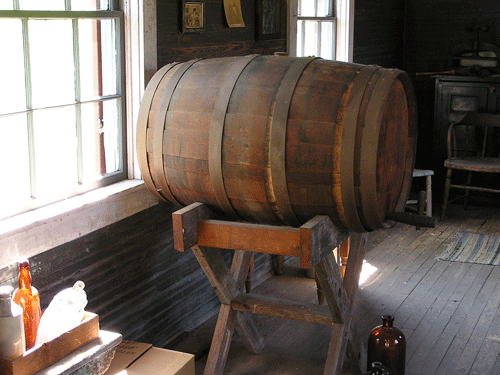

 I. Identification
I. Identification1. The Issue
Whiskey, which translates “water of life,” was brought to the New world by Irish settlers in the 18th century. It was in the western parts of Virginia, which would later become Kentucky, that the derivative known as bourbon was first created in late 1700's. Today, Kentucky Bourbon has evolved into one of the most known and respected distilled spirits traded worldwide. From the procedures of fermentation to the aging process, such stringent rules govern production that the United States has pursued a policy of protecting the cultural and environmental distinctiveness of this product. One may ask why Kentucky, and not Texas, and to that any bourbon distiller would say, it's as much about the land and crops as it is about culture and style.
2. Description
I. What is Bourbon?
While there are many types of whiskey, from Scotland and Ireland, to Canada and the US, bourbon is a special form created, distilled, and aged in the eastern United States, mainly in the state of Kentucky. It is classified as a distilled spirit made from a fermented mash, mainly consisting of corn, and aged in white oak barrels for at least two years. The unique nature of bourbon can be derived from the iron-free water used in the distillation process. Local distillers have used their resources to perfect a world class product with a distinct amber color, and natural flavor. Strict standards and regulations govern production and ensure excellence, but the bourbon story continues to be one of history and the pioneering spirit of early American colonies. For one thing, where did the name bourbon come from, for these and other bourbon facts, continue now on the journey through history, trade, and the environment.
III. The History
The American Colonies- In 1791, Alexander Hamilton imposed an excise tax on whiskey in western Pennsylvania. The farmers who lived on the frontier where mainly of Scottish and Irish descent and depended on whiskey as an important commodity produced from their excess corn and grain yields. They could transport the crops to Fort Pitt on the Ohio River (now Pittsburgh), but raids by Indians and the long distances between farms made whiskey production more practical. The new US government agreed and sent tax collectors to take their fair share, but settlers saw the situation as a mockery to the very principles of liberty and justice. They tarred and feathered the four tax collectors, and the Whiskey rebellion began in 1794. As a result, George Washington led an army of 13,700 men into Bedford, PA and quashed the rebellion. As a settlement, Washington offered incentives for pioneers to move southwest to the frontier of Virginia beyond the Allegheny mountains. However, in conjunction with this migration Thomas Jefferson offered sixty acres to his countrymen to "create a permanent structure and crops of native origin." [1]. This led to the foundation of Bourbon County in 1785, named after the French royal family (whose government helped the US defeat the British not long before). Bourbon was a rich agricultural area consisting of 34 modern day counties and around the turn of the nineteenth century, was on the main frontier of American westward expansion.
Bourbon County, KY- Kentucky was admitted to the union in 1792 and as farming region, was heavily dependent on two exports, hemp and whiskey. Trade was conducted at that time by water, and the closest outlet for the Bourbon region was the Ohio River on Kentucky's northern border. The Ohio flowed to the Mississippi, and eventually to the port of New Orleans on the Gulf of Mexico.
Upon the entrance of Kentucky into the union, Bourbon county was divided into smaller sub-regions, but economically speaking, products shipped from the area were still designated as coming from "Old Bourbon". Thus, whiskey shipped from the principal port of Limestone (now Maysville, KY) was designated "old bourbon whiskey" to refer to the origin of the product. After about 1840, the name was shortened to just bourbon [2]. Today, various styles, approaches, and theories govern the remaining distilleries which dot the Kentucky countryside. Various ratios of ingredients, subtleties in the distillation process, and the amount of aging yield different flavors of bourbons. In short, this process was one of experimentation, refinement and perfection in a brief, but rich history.
III. How Bourbon is Made
1. Grains- The main ingredient in bourbon is corn which varies from 51% to 79% depending on the brand. The other ingredients are rye, malted barley (10-15% each), and in some cases red winter wheat (10%). Distilleries are meticulous about selecting their crops, and once approved by quality control, the grains are stored in silos. The grains are ground in a hammer mille into a fine flour.
| 2. Mashing- The grain is placed in a mash cooker with iron-free water and cooked for approximately 30 minutes. The corn is cooked the longest at a temperature of 220 degrees Fahrenheit (F), the rye at 170F, and the barley 150F. The mix is then transported to a fermentation tank and it is called mash. |
| 3. Fermentation- At this stage, the yeast is prepared by placing a nutrient solution below a pear or apple tree. Once the solution has collected the yeast, it is placed in an oven, bred, and then left in stasis at around 95-100F. Only a small amount is removed (a few grams) and added to a malt extract. A mixture of approximately two cups of yeast is added to a large storage container called the "Dona Tub". Once the mash has been cooled to 75-85F, the yeast is added to the fermentation tank. The yeast breaks down the sugar in the mash converting it to alcohol and carbon dioxide over a period of three days. The alcohol is actually beer which is 10% alcohol/volume (20 proof). It is drained from the fermenting tube into a beer well. |
| 4. Distillation- To separate the whiskey, the beer is moved to the bottom of a still where it is heated at 200F. The liquid boils at the bottom and moves to the top in the form of a gas. The gas is filtered to a tank called a "thumper" where it is condensed. The liquid is called "low wine" and it is 45-65% alcohol/volume (90-130 proof). The liquid is then condensed again to further refine the flavor and it is now called "White Dog" or "high wine" (50-58% alcohol/volume or 100-116 proof). The White Dog is often sampled and then put in a barrel to mature. |
| 5. Cooperage- Bourbon must be stored in new, white oak barrels. The wood is cut into staves which are super heated and bent into ovular form. The barrel is then "toasted" by sending it through a small fire for about 12 minutes to caramelize the sugar in the wood. Next, it is applied to a larger fire for 6 to 12 seconds to burn out the inside and produce a charcoal layer. The charring must cover the barrel evenly so the whiskey has a consistent flavor. Finally the barrel is closed by a "Bung" and transported to the distilleries. Once the barrels have been used, they are often re-sold to age Scotch. |
| 6. Maturity- The barrels are transported to warehouses where they are placed using a series of elevators and moveable joints. Each barrel must stay for at least two years, and sometimes more depending on the position in the warehouse. A year consists of one cycle of expansion and contraction. When the temperature rises in the summer, the bourbon expands, and with lower temperatures in the winter, it contracts. This movement gives the bourbon its amber color and oak flavor. After a designated period, someone will open the barrel and taste if the whiskey is ready. If it meets the brand's standards, the barrel is opened, bottled, and shipped. |
Source: http://www.thewhiskystore.de/beginner/tmbw.htm
For other bourbon facts, refer to the Frequently Asked Questions of straightbourbon.com
3. Related Cases
The bourbon case is part of the food and beverage industry related to intellectual property. For a complete index of all of the case studies refer to the Trade and Environment Database. The most similar cases to bourbon are:
Basmati- This case involved US patent rights despite the clear Indian origin of the rice. It highlights cultural piracy and the notion that a substitute can never be the same as the original product.
Budweis- This case involves the dual naming rights between the US and the Czech Republic. It relates to bourbon if other countries were to use the process and obtain a domestic patent.
Scotch and Feta- These cases involve labeling rights and geographic indication based on naming.
Tequila- This case discusses cultural identification and distinctiveness related to trade and the environment.
Grappa- This case involves a trade dispute between similar products claimed by two nations. It gets to the heart of how intellectual property is determined.
Other wine, beer, and distilled spirits cases:
4. Author and Date: Mike Jones (April 2004)

 II. Legal
Clusters
II. Legal
Clusters5. Discourse and Status: Agreement and In progress
The Office of the United States Trade Representative has negotiated over the years to include Kentucky Bourbon and Tennessee Whiskey in international trade agreements. In the class of distilled spirits, these products are strictly defined by US law, and are therefore easily incorporated into foreign legal frameworks requiring precision and accuracy in production. While the recognition of Bourbon as a distinct product has been the most important goal of US trade officials, the main effort has been to reduce or eliminate tariffs for distilled spirits imported into foreign countries.
6. Forum and Scope: US and Bilateral, Multilateral

I. Standards of Production
On May 4, 1964 bourbon whiskey was recognized under US statutory law as a distinct product that could only be produced following certain standards. Title 27 (Alcohol, Tobacco Products, and Firearms) of the Code of Federal Regulations, Section 5.22 outlines the standards of identity. The five criteria are:
Also, the section clearly states "that the word 'bourbon' shall not be used to describe any whiskey or whiskey based distilled spirit not produced in the United States". These criteria provide the important guidelines for production, but in practicality, bourbon producers use a 70% corn mash, and the final bottling is somewhere between 40-50% alcohol/volume (80 to 100 proof).
II. Bottled-in-Bond
The Bottled-in-Bond Act of 1894 is another important legal measure that applies to the bourbon process. According to this law, bourbon can avoid federal excise taxes if it is "straight" as described in 27 CFR 5.22, aged at least 6 years, and 50% alcohol/volume (100 proof). The practical importance of this is it allows distilleries to bottle the bourbon and store it in a bonded warehouse until the tax is paid (at which time it may be sold). Here are some examples of Distilled Spirits Plant (DSP) designations:
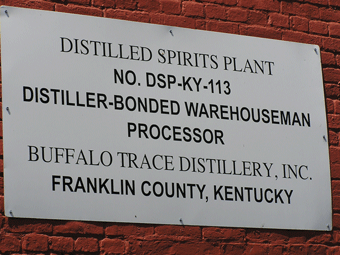
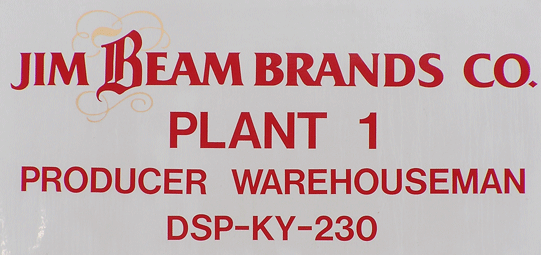
7. Decision Breadth: Canada, Mexico, Chile, the EU, Australia (in progress), WTO members
Trade in distilled spirits has been one of the most progressive areas in negotiations for geographic indication and intellectual property. Consequently, several global agreements, both bilateral and multilateral have been negotiated by the US to protect bourbon.
I. Bilateral Agreements
A. The North American Free Trade Agreement (NAFTA-US, Canada, and Mexico)


NAFTA was enacted on January 1, 1994 and in general provides a stringent enforcement mechanism for member countries. In the agreement, Chapter 3, Annex 313, titled "Distinctive Products", states that Canada and Mexico shall recognize both Bourbon Whiskey and Tennessee Whiskey as products of the US. In addition, these countries are committed to enforcing the standards of US law. In other words, they carry the burden of prohibiting sales of Bourbon and Tennessee whiskey within their own countries unless the products have been manufactured within the US according to 27 CFR 5.22. The US in turn afforded the same protection to Canadian Whiskey and Tequila and Mezcal for Mexico.
These provisions governing intellectual property are very important for an industry relying on brand recognition to maintain market share. This aspect of the NAFTA agreement effectively transplants US law through a treaty to Canada and Mexico. In practice, Mexico eliminated its 20% tariff on bourbon immediately following NAFTA's creation [3].
B. US-Chile Free Trade Agreement

On June 6, 2003 the US entered its first comprehensive trade agreement with a South American country. The three benefits afforded to distilled spirits and bourbon in particular are:
C. US-EU Agreement on Nomenclature for Distilled Spirits

In June, 1994 the US and the European Union reached an agreement in which each side would exclusively recognize goods based on specific origin. The EU recognized Bourbon and Tennessee Whiskey as products that must be produced in the US under the standards of US law. The EU law relating to this topic is EEC Council Regulation No 1576/89, but the 1994 agreement entered as a new regulation, EEC 1267/94.
In exchange, the US offered protection under its own naming standards in 27 CFR 5.22, giving EU law full weight in the US. The protected products are:
D. US-Australia Free Trade Agreement

On February 8, 2004, the US and Australia released draft text for a free trade agreement that would eliminate tariffs on distilled spirits between the two nations. Australia currently has a 5% duty on all US spirit imports. Bourbon and Tennessee Whiskey also received the special protections afforded in the US-Chile Agreement. Once signed and approved, this agreement will be an important legal victory for both products which consist of about 80% of US distilled spirit exports to Australia in 2003 [5].
For more on this agreement see the office of the US Trade Representative.
II. Multilateral Agreements
A. The World Trade Organization (WTO)
Geographical indication (GI) and intellectual property rights concerned with Bourbon are discussed in a multilateral forum in two places. The first is the WTO's Trade Related Aspects of Intellectual Property Rights (TRIP's) Council established by the Uruguay Round in 1994. For distilled spirits, the US and the other 146 members (as of April 2004) are subject to Section 3, Article 23 of the Agreement on TRIPS which states that:
"Each member shall provide the legal means for interested parties to prevent use of a geographic indication identifying wines for wines not originating in the place indicated by the geographical indication in question, even where the true origin of the goods is indicated or the geographical indication is used in translation or accompanied by expressions such as 'kind, 'type', 'style', 'imitation', or the like." [6]
The EU in particular has advocated in the Doha Round to extend Article 23 protection to other areas, but the US and others are opposed since changes would focus on mandatory GI protection and registration of products. Bourbon protection under the WTO is legally sound, but enforcement may be limited in the future, especially in the developing world, if there is not a specific system to record product standards.
B. The World Intellectual Property Organization (WIPO)
The second forum is WIPO's standing committee on the law of trademarks, industrial designs, and geographical indications. WIPO is a member of the UN's specialized agency system and holds annual meetings dealing with GI. In July of 2003, the world symposium held in San Francisco, CA looked at how GI enhances a trademark. The conclusion was that GI not only differentiated a product, but it provided a "token a quality" incorporating the product's origin, environment, and "time-honored know-how" [7].
 Click on the logo for further GI
information.
Click on the logo for further GI
information.
8. Legal Standing: Treaty

 III. Geographic Clusters
III. Geographic Clusters9. Geographic Locations
a. Geographic Domain: North America
b. Geographic Site: Eastern North America
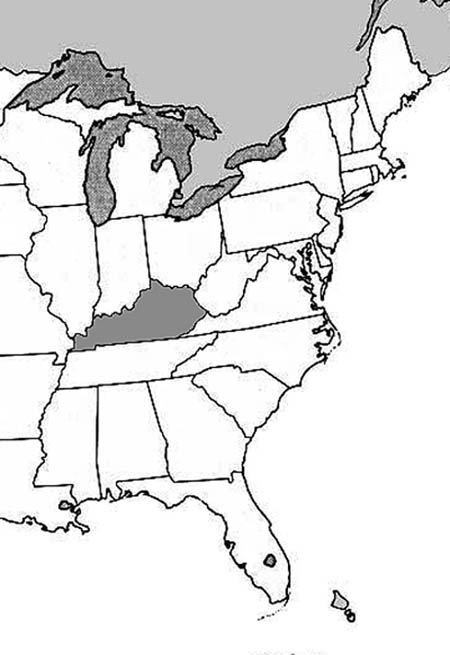
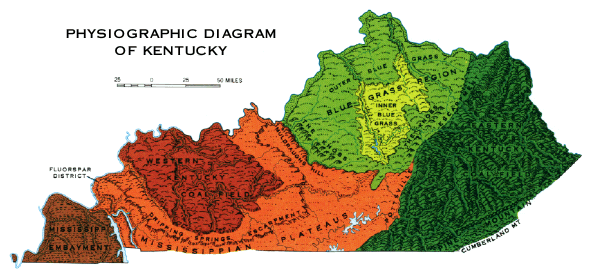
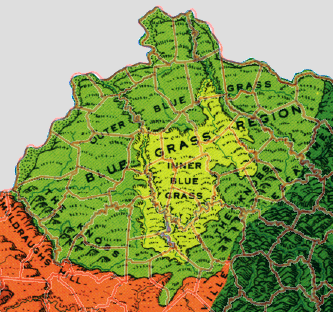
c. Geographic Impact: United
States
10. Sub-National Factors: Yes
The Blue Grass region of Kentucky is home to the distilleries which make
about 9 out of every 10 bottles of bourbon in the US. The other 10% comes from
Minnesota, Florida, Maryland, New Jersey, California, Virginia, Missouri, and
Pennsylvania.
However, what truly makes bourbon a product of Kentucky?
Most distillers point to the limestone which forms the bedrock of this region.
Kentucky was once a shallow, tropical ocean filled with shelled crustaceans that
dried up over time, formed fossils, and subsequently, limestone. The principle
minerals in limestone are calcium carbonate and magnesium which act as a base
when put in contact with acid. Thus, if slightly acidic water is filtered
through limestone, a high concentration of minerals is released into the ground
soil, helping the crop yield, the water, and the nutrients needed for the yeast
in the fermentation process. The better the yeast, the better the breakdown of
the sugars to alcohol in the mash.[8].
Another advantage of Kentucky's geography is the
limestone breaks down overtime to form massive caves (read more on Kentucky Cave Formation). The
springs which flow from these caves provide iron-free water sources for the
bourbon process. The Mammoth Cave in southern Kentucky is just one example, with
the deepest passageway of any natural formation in the world. It is this
combination of filtering, pure water, and rich agricultural conditions which
make Kentucky the prime geographical location for production within the United
States.
11. Type of Habitat: Temperate, limestone plateau with rolling hills

 IV. Trade Clusters
IV. Trade Clusters12. Type of Measure: Intellectual Property; Culture
International sales of Kentucky bourbon have increased at a rapid pace in the last ten years in both the industrial and developing world. Lower tariff barriers, legal protection, and the creation of a world-class product have been some of the key factors in securing a growing market share. Out of US distilled spirits alone, bourbon accounted for 66.3% of the total value exported in 2003, with a $38.7 million increase in sales from 2002 to 2003. A spokesman from the Distilled Sprits Council of the United States notes that "Europeans, sophisticated Asians and those in the South Pacific and Australia and New Zealand have developed a very high-end taste for our products, and that is driving growth for the industry." [9].
Kentucky distilleries account for 90% of the US bourbon produced, and with so few firms supplying the world demand, there is an ideal export market. The legal protection afforded in several agreements and the brand recognition that these firms have commanded continues to show promising results. Wild Turkey and Jim Beam in particular show a healthy dependence on trade with 40 and 35 percent of sales respectively consisting of exports. The only real competition that bourbon distilleries face is from international whiskey and Jack Daniel's Tennessee Whiskey (the largest US distilled spirit export).
The Harmonized Tariff Schedule (HTS) from the US International Trade Commission for 2004 categorizes whiskey imports other than Irish and Scotch types as #22083060. The Most Favored Nation duty rate is currently 0.0, indicating that free trade has been an effective policy for whiskey. In fact, in 2003, the US only imported whiskey from 9 countries, and 98.9% of the total amount was from Canada, at an impressive 265 million dollars. This is a clear indication that substitutes may exist, but the US domestic market for bourbon is still quite strong.
13. Direct v. Indirect Impacts: Indirect
14. Relation of Trade Measure to Environmental Impact: Directly Related to Product and Process
15. Trade Product Identification: Kentucky Straight Bourbon Whiskey
16. Economic Data
.gif) Top 10
Destinations for 2003 exports of bourbon
Top 10
Destinations for 2003 exports of bourbon
| Country | Value (USD) | Volume (gallons) |
| UK | 87,042,302 | 2,895,394 |
| Germany | 64,945,892 | 2,614,775 |
| Australia | 49,447,732 | 5,364,757 |
| Japan | 36,708,722 | 2,051,930 |
| Spain | 24,838,110 | 478,839 |
| France | 23,681,302 | 622,150 |
| Italy | 20,164,590 | 434,404 |
| Canada | 11,408,026 | 537,680 |
| New Zealand | 8,321,417 | 764,493 |
| Greece | 5,328,102 | 115,247 |
Source: http://www.discus.org/economic/files/2003/Distilled_Spirits_Exports_Value_December2003.pdf
http://www.discus.org/economic/files/2003/Distilled_Spirits_Exports_Volume_December2003.pdf
17. Impact of Trade Restriction: The US (Kentucky) produces Bourbon exclusively; import ban
18. Industry Sector: Food
19. Exporters and Importers: US and several
Top Exporters
When referring to bourbon exporters, there are only 12 or so distilleries (some have closed or are private stocks) of various size which manufacture Kentucky straight bourbon whiskey. For a list by brand access the Bourbon Database. Here are links to some distilleries to take a virtual tour. Keep in mind, while a distillery may produce multiple brands like Buffalo Trace, Makers Mark maintains that one recipe can be just as succesful.
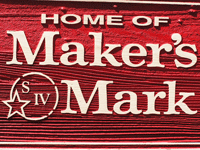 Maker's Mark, Loretto, KY
Maker's Mark, Loretto, KY 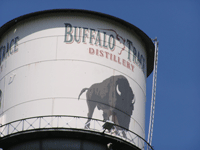 Buffalo Trace,
Frankfurt Co., KY
Buffalo Trace,
Frankfurt Co., KY
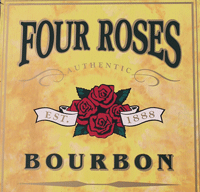 Four Roses, Lawrenceburg, KY
Four Roses, Lawrenceburg, KY 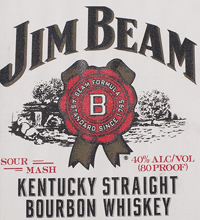 Jim Beam, Clermont, KY
Jim Beam, Clermont, KY
| Wild Turkey, Lawrenceburg, KY | Labrot & Graham, Versailles, KY |
| Heaven Hill, Bardstown, KY | Barton Brand, Bardstown, KY |
| McLain & Kyne, Bardstown, KY | Early Times, Louisville, KY |
| Old Rip Van Winkle, Louisville, KY | Kentucky Bourbon Distillers, Bardstown, KY |


 V. Environment Clusters
V. Environment Clusters20. Environmental Problem Type: N/A
21. Name, Type, and Diversity of Species
Name: Corn, barley, rye, red winter wheat, yeast
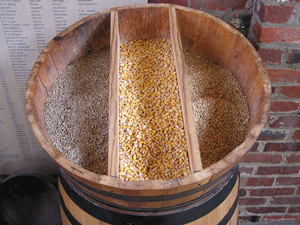
Type: Agricultural products and active yeast cultures
Diversity: Every bourbon recipe has a different culture
The yeast in Bourbon (Saccharomyces cerevisiae) contains the living microbes that initiate fermentation. Each distillery has its own culture which is the natural ingredient differentiating brands, and thus, a closely guarded secret by master distillers.
22. Resource Impact and Effect: Low and Product
In the future, global warming may affect the weather patterns which are essential in Kentucky for the aging process. The warehouses which dot the countryside depend on shifting seasons for the barrels to expand and contract. A barrel in the top along the side of the warehouse is exposed to more temperature variation than a similar barrel on the bottom floor. In fact, the cyclical fashion in which the seasons fluctuate gives bourbon the ability to effectively mature. In Florida, bourbon would not have the cold nights needed for the barrels to contract, and in Alaska, it would be difficult to reach the warm climate required for expansion. The south east United States provides the perfect median and highlights an important connection between production and the local environment.
23. Urgency and Lifetime: Low and 100's of years
24. Substitutes: Like Products
Bourbon is well regarded as a distinct product, but similar flavors can be found in blended or sour-mash whiskey (the latter is slightly milder in taste). In addition, Scotch is a good substitute for sipping while Cognac can be used for cooking. Jack Daniel's Tennessee Whiskey, while often considered the most popular brand, is in fact not bourbon because its original flavor is altered through the charcoal filtration process.

 VI. Other Factors
VI. Other Factors25. Culture: Yes
Beyond its taste and character, bourbon has a rich tradition which helps define Kentucky's culture. The rolling hills boast rich green farmland known for competitive horse breeding, but when work is done folks take their bourbon just as seriously.
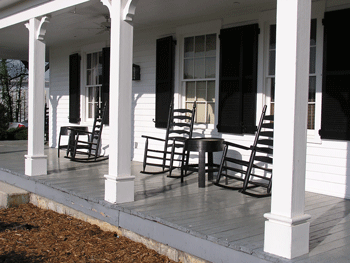
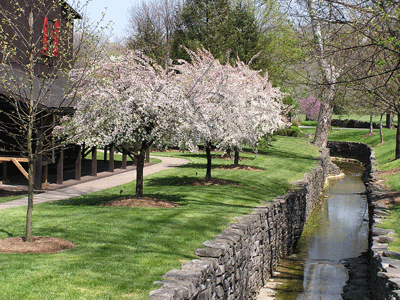
Jim Beam Distillery, Clermont, KY ----------------------------------- Maker's Mark Distillery, Loretto, KY
The Oscar Getz Museum of Whiskey History located in Bardstown, KY is a testament to the industry with documents and facts dating back to Kentucky's settlement. Copper stills from 1787, pre-Prohibition bottles, photographs of women in the early distilling process, and old myths are some of the things on display.
Today, people from all over the US come to Bardstown for the Kentucky Bourbon Festival which takes place annually in September. This exhibition, attracting local business and events, showcases the area for local enthusiasts and traveling connoisseurs.
|
Festivals, history, and pride, are a few of the elements
of bourbon culture. If the pioneers who came to the Bluegrass region in
late 1700's had only imagined how their creation would command
international respect, the industry may have grown purely on business.
While this is surely important, it leaves out the open porches and
wandering streams that have inspired generations of master distillers. It
is surely work the visit to see and experience the Bourbon
Trail. Once you're there you can see that Kentucky is bourbon's
source, and without bourbon, Kentucky would be a different place.
|
26. Trans-Boundary Issues: International Trade and Kentucky's cultural history
27. Rights: Intellectual Property
28. Relevant Literature
Alliance Beverage Distributing Company. http://www.alliance-beverage.com/page.cfm?PageID=28&Refer=6. (4/20/04).
Cocktail Times. http://www.cocktailtimes.com/bourbon/
[9] Collins, Mike. Bourbon's on a Roll. The Kentucky Post.http://www.kypost.com/2003/06/02/bourb060203.html.
[2] Cowdery, Charles. How Bourbon Whiskey Really Got Its Famous Name. The Bourbon County Reader. http://home.netcom.com/~cowdery/articles/name.html.
Distilled Spirits Council of the United States (International Distilled Spirits Lobby): http://www.discus.org/
[1] http://cocktails.about.com/library/weekly/aa050299.htm. (4/30/04).
http://encyclopedia.thefreedictionary.com/Bourbon%20whiskey. (4/20/04).
http://www.realbeer.com/maltadvocate/W94/W94BOURB.html. (4/20/04).
http://www.straightbourbon.com/ - Straight Bourbon: Makers, History, Brands, Tasting, Reviews, FAQ
Official Web site of the Kentucky Bourbon Distillers Association: http://www.kybourbon.com/
Old Rip Van Winkle History. http://www.oldripvanwinkle.com/newbs/vw/website3.nsf/PagesByName/History?opendocument&t=History.
[8] Reigler, Susan. Kentucky Rocks. The Courier Journal. http://www.courier-journal.com/features/2003/06/20030601.html.
Swaine, Margaret. Kentucky Bourbon. http://www.margaretswaine.com/bourbon.htm. (4/20/04).
The Trade Promotion Authority (International State and Sector statistics): http://www.tpa.gov/
The Whiskey Store- a German site with pictures and information. http://www.thewhiskystore.de/whisky_uk.htm. (4/30/04).
Tour of Buffalo Trace Distillery. (4/24/04).
Tour of Jim Beam Distillery. (4/24/04).
Tour of Maker's Mark Distillery. (4/24/04)
[5] US-Australia Free Trade Agreement- http://www.discus.org/mediaroom/2004/release.asp?pressid=140. (4/26/04).
[4] US-Chile Free Trade Agreement- http://www.ustr.gov/new/fta/Chile/final/
US Code of Regulations. http://www.access.gpo.gov/nara/cfr/.
[3] US Department of Agriculture. Foreign Agricultural Service. http://www.fas.usda.gov/. (4/26/04).
US Department of Agriculture. Economic Research Service. http://www.ers.usda.gov/Briefing/WTO/geoindications.htm. (4/26/04).
Vaughan, Mark. The Spirits of Kentucky: Small-Batch and Single-Barrel Bourbons Revive the Good Old Days of Whiskey. http://www.straightbourbon.com/history.html.
[7] WIPO meeting notes 7/23/03. http://216.239.39.104/search?q=cache:1b2_k0UCPcEJ:www.wipo.org/meetings/2003/geo-ind/fr/documents/pdf/wipo_geo_sfo_03_23rev.pdf+WIPO+bourbon&hl=en&client=REAL-tb. (1/27/04).
[6] WTO TRIP's Agreement. http://www.wto.org/english/docs_e/legal_e/27-trips_04b_e.htm#3.